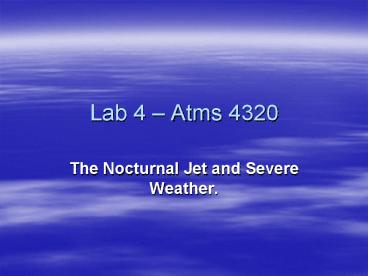Lab 4 Atms 4320 - PowerPoint PPT Presentation
1 / 23
Title:
Lab 4 Atms 4320
Description:
... and Severe Weather. ... of in the fair weather ridge (most convection that fires ... moist air can lead to a favorable environment for severe weather. ... – PowerPoint PPT presentation
Number of Views:108
Avg rating:3.0/5.0
Title: Lab 4 Atms 4320
1
Lab 4 Atms 4320
- The Nocturnal Jet and Severe Weather.
2
The Nocturnal Jet and Severe Weather.
- This is a low-level jet found over the southern
plains and midwest (East of the Rocky Mountains).
3
The Nocturnal Jet and Severe Weather.
- It may be east or northeast of a low-level trough
or cyclone, and ahead of a cold front. This
feature is associated with copious low-level
moisture transport and can feed into convective
systems, MCCs and MCSs.
4
The Nocturnal Jet and Severe Weather.
- Northerly Jet?
- The LL Cool J
5
The Nocturnal Jet and Severe Weather.
- These low-level jets, called the southern plains
low-level jet is driven by topography and has a
distinct diurnal oscillation (strongest at night
and weakest during the day). - Typically associated with the dry line, thus
dry-line convection can also demonstrate a
distinct diurnal variation.
6
The Nocturnal Jet and Severe Weather.
- ?
7
The Nocturnal Jet and Severe Weather.
- The dryline
- sharp moisture gradients between moist Gulf air
and dry desert air. - get strong convergence along this line, and
theres a distince windshift. - diurnal oscillation of in the fair weather ridge
(most convection that fires up, fires up within
200 mi of the dry line and become a squall line. - the dry line moves eastward during the day
(toward the Gulf), and westward at night (toward
the Rockies)
8
The Nocturnal Jet and Severe Weather.
- Moist air acts like a pool hanging on the
continent, thus the density differences between
the moist and dry air drive the circulations.
9
The Nocturnal Jet and Severe Weather.
- Sea breeze type transverse circulations develop
in association with the dry line, driving
convection.
10
The Nocturnal Jet and Severe Weather.
- Soil moisture plays a role in the development of
a strong dry line, thats why this phenomena is
common in the spring and early summer.
11
The Nocturnal Jet and Severe Weather.
- Modelling studies have shown that
- soil moisture is important in determining the
strength of the dry line. - wind shear is important also, but
- without the sloping terrain, little or no
development of a dryline.
12
The Nocturnal Jet and Severe Weather.
- Density differences between the dry air and moist
air can lead to a favorable environment for
severe weather. - Generally studied using numerical models, and
generally studied as a geostrophically balanced
system. The equations used are the
two-dimentional linearized basic equations, or a
Boussinesq fluid.
13
The Nocturnal Jet and Severe Weather.
- Boussinesq fluid (pp 197 - 198 Holton)
(especially useful for boundary layer studies) - Non divergent
- Small Rossby Number
- Barotropic (ie density a function of pressure
only) and incompressible system
14
The Nocturnal Jet and Severe Weather.
- Rotation effects can be neglected.
- Shallow water system of equations. Based on
assumptions above, this system is valid for
disturbances that have a depth shallower than the
e-folding depth of the atmosphere (H) which is
roughly 8 km.
15
The Nocturnal Jet and Severe Weather.
- Linearized equations where
16
The Nocturnal Jet and Severe Weather.
- Holton (2004) pp. 197ff combines these
17
The Nocturnal Jet and Severe Weather.
- Can solve analytically (for c) by assuming some
wave type solution. Where
18
The Nocturnal Jet and Severe Weather.
- m wave number in the vertical
- k wave number in the horizontal
- c phase speed (propagation speed of the
principal wave components)
19
The Nocturnal Jet and Severe Weather.
- Example (in x,t coordinates)
- (1) (2)
20
The Nocturnal Jet and Severe Weather.
- Operation 1
21
The Nocturnal Jet and Severe Weather.
- Operation 2
22
The Nocturnal Jet and Severe Weather.
- Then, from above
- Divide both sides by
- And we get
23
The Nocturnal Jet and Severe Weather.
- The End!!!!!































